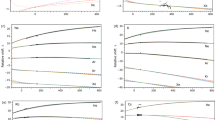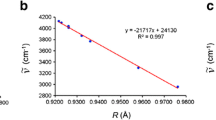Summary
Proton isotropic hyperfine coupling constants have been calculated for three low-energy nuclear conformations on the ground state potential surface of the propane cation, using a multireference singles and doubles configuration interaction (MR-SDCI) wave function. The lowest point found on the potential surface hadC 2v symmetry and the electronic wave function at this point had2B2 symmetry. At this point, the largest isotropic coupling constant is calculated to be 88.6 G, which is in fair agreement with the experimental value of 98 G obtained in an SF6 matrix at 4 K. No support is found for a “long-bond” ground state of lower symmetry thanC 2v . AnotherC 2v minimum on the ground state potential energy surface was found at which the wave function had2 B 1 symmetry. At this point, two large coupling constants of 198 G and 35 G were calculated. AC 2v stationary point was also found on the ground state potential surface at which the wave function had2 A 1 symmetry. At this point, couplings of 86 G and 25 G were obtained. None of these agree closely with the other experimental result of couplings at both 100–110 G and 50–52.5 G which was obtained in freon matrices. It is suggested that the latter spectra might correspond to a dynamical average of two distorted2 A' states inC s symmetry.
Similar content being viewed by others
References and notes
For a recent review, see: Lund A, Lindgren M, Lunell S, Maruani J (1989) In: Maruani J (ed) Molecules in physics, chemistry, and biology, vol 3, pp 259–300
Becker D, Plante K, Sevilla MD (1983) J Phys Chem 87:1648
Toriyama K, Nunome K, Iwasaki M (1982) J Chem Phys 77:5891
Lunell S, Huang MB, Lund A (1984) Faraday Discuss Chem Soc 78:35
Feller D, Davidson ER (1984) J Chem Phys 80:1006; Theor Chim Acta 68:57 and references therein
The MELD suite of programs was developed by Davidson ER and coworkers, Department of Chemistry, Indiana University, Bloomington, Indiana
Van Duijneveldt FB (1971) IBM Technical Report RJ945
Tanaka K, Davidson ER (1979) J Chem Phys 70:2904
Feller D, Davidson ER (1981) J Chem Phys 74: 3977
GAUSSIAN 82, Binkley JS, Frisch MJ, DeFrees DJ, Raghavachari K, Whiteside RA, Schlegel HB, Fluder EM, Pople JA (1980) Department of Chemistry, Carnegie-Mellon University, Pittsburgh, PA
Davidson ER, Silver DW (1977) Chem Phys Letters 52:403
Bouma WJ, Poppinger D, Radom L (1983) Israel J Chem 23:21
Lunell S, Huang M-B (1989) J Chem Soc Chem Comm 1931
Bellville DJ, Bauld NL (1982) J Am Chem Soc 104:5700
Feller D, Huyser, ES, Borden WT, Davidson ER (1983) J Am Chem Soc 105:1459
Frey RF, Davidson ER (1988) J Chem Phys 88:1775; Paddon-Row MN, Fox DJ, Pople JA, Houk KN, Pratt DW (1985) J Am Chem Soc 107:7696
Author information
Authors and Affiliations
Rights and permissions
About this article
Cite this article
Lunell, S., Feller, D. & Davidson, E.R. Configuration interaction calculations on the propane radical cation, C3H +8 . Theoret. Chim. Acta 77, 111–122 (1990). https://doi.org/10.1007/BF01114536
Received:
Revised:
Accepted:
Issue Date:
DOI: https://doi.org/10.1007/BF01114536




